صرد
| Shrikes | |
|---|---|
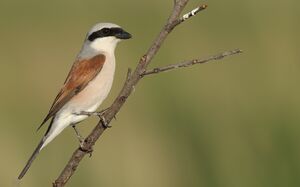
| |
| Red-backed shrike (Lanius collurio) | |
| التصنيف العلمي | |
| أصنوفة غير معروفة (أصلحها): | Laniidae |
| Genera | |
الصرد (Shrikes ؛ /ʃraɪk/) are carnivorous passerine birds of the family Laniidae. The family is composed of 34 species in four genera.
The family name, and that of the largest genus, Lanius, is derived from the Latin word for "butcher", and some shrikes are also known as butcherbirds because of their feeding habits.[1] The common English name shrike is from Old English scrīc, alluding to the shrike's shriek-like call.[2]
التوزع والهجرة والموئل
Most shrike species have a Eurasian and African distribution, with just two breeding in North America (the loggerhead and northern shrikes). No members of this family occur in South America or Australia, although one species reaches New Guinea. The shrikes vary in the extent of their ranges, with some species such as the great grey shrike ranging across the Northern Hemisphere to the Newton's fiscal which is restricted to the island of São Tomé.[3]
They inhabit open habitats, especially steppe and savannah. A few species of shrikes are forest dwellers, seldom occurring in open habitats. Some species breed in northern latitudes during the summer, then migrate to warmer climes for the winter.
الوصف
Shrikes are medium-sized birds with grey, brown, or black and white plumage. Most species are between 16 cm (6.3 in) and 25 cm (9.8 in) in size, however, the genus Corvinella with its extremely elongated tail feathers may reach up to 50 cm (20 in) in length. Their beaks are hooked, like those of a bird of prey, reflecting their predatory nature, and their calls are strident.
السلوك
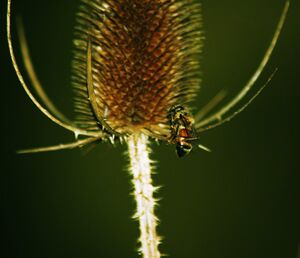
Shrikes are known for their habit of catching insects and small vertebrates and impaling their bodies on thorns, the spikes on barbed-wire fences, or any available sharp point. This helps them to tear the flesh into smaller, more conveniently sized fragments, and serves as a cache so that the shrike can return to the uneaten portions at a later time.[4] This same behaviour of impaling insects serves as an adaptation to eating the toxic lubber grasshopper, Romalea microptera. The bird waits 1–2 days for the toxins within the grasshopper to degrade, when they can then eat it.[5]
Loggerhead shrikes kill vertebrates by using their beaks to grab or pierce the neck and violently shake their prey.[6]
Shrikes are territorial, and these territories are defended from other pairs. In migratory species, a breeding territory is defended in the breeding grounds and a smaller feeding territory is established during migration and in the wintering grounds.[3] Where several species of shrikes exist together, competition for territories can be intense.
Shrikes make regular use of exposed perch sites, where they adopt a conspicuous upright stance. These sites are used to watch for prey and to advertise their presence to rivals.
التهجين
Shrikes are generally monogamous breeders, although polygyny has been recorded in some species.[3] Co-operative breeding, where younger birds help their parents raise the next generation of young, has been recorded in both species in the genera Eurocephalus and Corvinella, as well as one species of Lanius. Males attract females to their territory with well-stocked caches, which may include inedible but brightly coloured items. During courtship, the male performs a ritualised dance which includes actions that mimic the skewering of prey on thorns, and feeds the female. Shrikes make simple, cup-shaped nests from twigs and grasses, in bushes and the lower branches of trees.[4]
الأنواع في رتبة تصنيفية
The family Laniidae was introduced (as Lanidia) by the French polymath Constantine Samuel Rafinesque in 1815.[7][8]
FAMILY: LANIIDAE[9]
| الصورة | الجنس | الأنواع الحية |
|---|---|---|
 |
Lanius Linnaeus, 1758 |
|
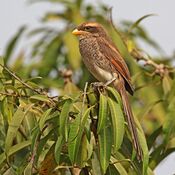 |
Corvinella Lesson, 1831 |
|
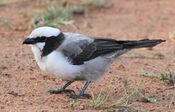 |
Eurocephalus A. Smith, 1836 |
|
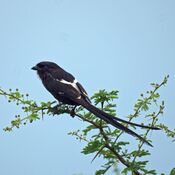 |
Urolestes Cabanis, 1851 |
|
طيور بأسماء مشابهة
Other species with names including the word shrike, due to perceived similarities in morphology, are in the families:
- Vangidae, vangas, helmetshrikes, woodshrikes, flycatcher-shrikes, shrike-flycatchers and philentomas
- Malaconotidae, bushshrikes, puffbacks, tchagras and boubous
- Campephagidae, cuckooshrikes, trillers and cicadabirds
- Falcunculidae, shriketits
- Pachycephalidae, whistlers and shrikethrushes
- Platylophidae, the crested shrikejay
- Vireonidae, vireos, including Cyclarhis peppershrikes, Vireolanius shrike-vireos and Pteruthius shrike-babblers
- Platysteiridae, wattle-eyes and batises, including the white-tailed shrike
- Thraupidae, tanagers, including the shrike-like tanager and Lanio shrike-tanagers
- Monarchidae, monarchs, including Clytorhynchus shrikebills
- Thamnophilidae, antbirds, antshrikes, antwrens and antvireos
- Tyrannidae tyrant flycatchers, including Agriornis shrike-tyrants
- Tityridae, becards and allies, including Laniisoma shrike-like cotingas
The helmetshrikes and bushshrikes were formerly included in Laniidae, but they are now known to be not particularly closely related to true shrikes.
The Australasian butcherbirds are not shrikes, although they occupy a similar ecological niche.
في الروايات
A shrike features in the 1979 book series The Animals of Farthing Wood by English author Colin Dann, and in the subsequently televised British-French animated series by the same name in a 1993 episode entitled "New Friends, Old Enemies".[10]
Pulitzer Prize-winning play The Shrike is about a bitter, vindictive wife who uses the occasion of her husband's suicide attempt to imprison him in an insane asylum, until she regains full control over his life.
In Michael Connelly's 2020 novel, Fair Warning, a serial killer is named "The Shrike" because he snaps the necks of his victims.[11]
In the science fiction novel Hyperion, by Dan Simmons, the central antagonist is a strange creature, perhaps cybernetic and futuristic in origin, that has the ability to appear in any area of space and time, kidnapping seemingly random individuals. These victims are later seen impaled on an impossibly large metal tree of thorns, agonized eternally. This gives the entity a quality not unlike this bird, although it does not consume its victims for sustenance. The entity is referred to simply as The Shrike.
In the Mortal Engines book series by Philip Reeve, and in the movie adaption, a 'Stalker', named "Shrike", is one of the main characters: a resurrected bounty hunter who was once part of a military unit known as the Lazarus Brigade, of which all members were named after birds, hence how Shrike got his name. In the American versions of the novels however, Shrike is renamed to "Grike", possibly to avoid legal issues with Dan Simmons' "Hyperion", which has a creature known as "The Shrike".
In the Edge Chronicles book series by Paul Stewart and Chris Riddell, the Shrykes are a species of sapient, bipedal birds, known for their cruelty, viciousness, and practice of slavery.
In the short story "The Lesser Evil" by Andrzej Sapkowski, from his The Witcher series, the suspected monster Renfri is called Shrike due to her alleged habit of impaling living people on poles.
In Hannibal (TV series), fictional serial killer Garret Jacob Hobbs is known as the "Minnesota Shrike" due to the way that he mounted his victims on deer antlers, similar to the way that the shrike impales its victims on spikes.
In Sabaa Tahir’s “An Ember in the Ashes” novel series, the Emperor’s second in command is called “Blood Shrike” and must revoke her given name upon gaining the title.
In the Honor Harrington science fiction series by David Weber, the second generation light attack craft (LAC) spaceships are called Shrikes.
الهامش
- ^ Jobling, James A (2010). The Helm Dictionary of Scientific Bird Names. London: Christopher Helm. p. 219. ISBN 978-1-4081-2501-4.
- ^ "Shrike". Oxford English Dictionary (Online ed.). Oxford University Press. قالب:OEDsub
- ^ أ ب ت Yosef, Reuven (2008). "Family Laniidae (Shrikes)". In Josep, del Hoyo; Andrew, Elliott; David, Christie (eds.). Handbook of the Birds of the World. Volume 13, Penduline-tits to Shrikes. Barcelona: Lynx Edicions. pp. 732–773. ISBN 978-84-96553-45-3.
- ^ أ ب Clancey, P.A. (1991). Forshaw, Joseph (ed.). Encyclopaedia of Animals: Birds. London: Merehurst Press. p. 180. ISBN 1-85391-186-0.
- ^ Yosef, Reuven; Whitman, Douglas W. (1992). "Predator exaptations and defensive adaptations in evolutionary balance: No defence is perfect". Evolutionary Ecology. 6 (6): 527–536. doi:10.1007/BF02270696. S2CID 23312866.
- ^ Sustaita, Diego; Rubega, Margaret A.; Farabaugh, Susan M. (2018). "Come on baby, let's do the twist: the kinematics of killing in loggerhead shrikes". Biology Letters. 14 (9). doi:10.1098/rsbl.2018.0321. PMC 6170751. PMID 30185607.
- ^ Rafinesque, Constantine Samuel (1815). Analyse de la nature ou, Tableau de l'univers et des corps organisés (in الفرنسية). Palermo: Self-published. p. 67.
- ^ Bock, Walter J. (1994). History and Nomenclature of Avian Family-Group Names. Bulletin of the American Museum of Natural History. Vol. Number 222. New York: American Museum of Natural History. pp. 150, 252. hdl:2246/830.
- ^ Gill, Frank; Donsker, David, eds. (2019). "Shrikes, vireos & shrike-babblers". World Bird List Version 9.2. International Ornithologists' Union. Retrieved 14 August 2019.
- ^ "Nightmare Fuel / The Animals of Farthing Wood". TV Tropes. Retrieved 25 September 2021.
- ^ Connelly, Michael (2020). Fair Warning. Little, Brown and Company. ISBN 978-0316539425.
للاستزادة
- Fuchs, J.; Alström, P.; Yosef, R.; Olsson, U. (2019). "Miocene diversification of an open‐habitat predatorial passerine radiation, the shrikes (Aves: Passeriformes: Laniidae)" (PDF). Zoologica Scripta. 48 (5): 571–588. doi:10.1111/zsc.12363. S2CID 202027002.
وصلات خارجية
- Shrike videos on the Internet Bird Collection
- . . 1914.
- Thurber story
- CS1 الفرنسية-language sources (fr)
- Short description is different from Wikidata
- Articles with hatnote templates targeting a nonexistent page
- Automatic taxobox cleanup
- Articles containing إنگليزية القديمة (ح. 450-1100)-language text
- Wikipedia articles incorporating citation to the NSRW
- Wikipedia articles incorporating citation to the NSRW with an wstitle parameter
- Laniidae
- صرد
- Taxa named by Constantine Samuel Rafinesque